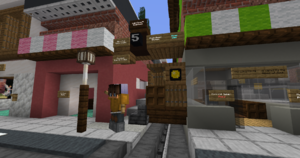Warp trains
Warp trains, warp rail, or warp train rail is a method of transportation on the MRT Server. Found on the New World, warp railways emulate real-life railways through design. Warp signs, found within a train, are used to teleport riders from station to station and range from local services to vast intercity networks.
History
Early warp trains
The first warp rail company to be established was RaiLinQ in May of 2015. Created by autobus22, the route ran between Oakley and Sealane. Oakley station would open on May 20th, but the route would not be operational until Sealane station opened on June 9th, 2015. This original line would subsequently get shut down, only to reopen later in July 2015 after a physical connection was built between the two stations. RaiLinQ's train and track design, three-block-wide trains using anvils embedded in a stone or cobblestone ballast, would eventually become a standard for future warp rail companies.
At an unknown point sometime during the Gamma era, NKTransit was founded. It ran two Amtrak-inspired services from Washingcube to Espil via Utopia, and Washingcube to Laclede. Its track design is notable for using stairs as rails instead of anvils, as well as having railroad ties (a design usually seen in five-wide track design).
IntraRail, founded on October 9, 2016, was a major warp rail company. It originally served the Zaquar and Whiteley region before significantly expanding north to Pine Mountain and beyond.
Fred Rail was a late Gamma warp rail company, forming in mid-to-late December before Christmas. Fred Rail was notable for originally serving both three-wide and five-wide trains, as seen at its first station Fort Yaxier West.
Epsilon-era transit
Trains
Warp rail trains vary in size, shape, and gauge. Most warp rail trains use a standard three-block gauge, typically with anvils as rails and some sort of ballast in between. Most three-wide trains have a floor one block above the rail, with two blocks of clearance inside the train, and a roof. Five-wide trains typically use three-block track, though often require more clearance in tunnels due to their larger nature.
Urban warp rail services typically use smaller trainsets customized for local needs. A great example is Nuuk's CubeTram, which uses a unique two-block wide gauge and train.
